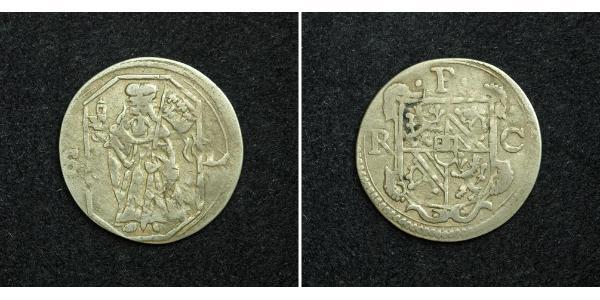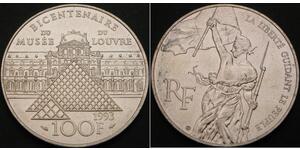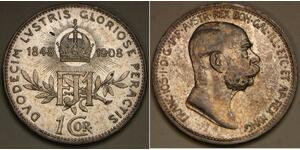(售价 $46.0)
1648, Klosterneuburg Abbey, Provost Rudolf Mullner. Silver St. Leopold Pfennig.
Condition: VF
Mint Period: 1643-1648
Mint Place: Klosterneuburg
Reference: Nentwich 50, KM-. R!
Provost: Rudolf Mullner (1643-1648)
Denomination: St. Leopold Pfennig ("Leopoldspfennig")
Diameter: 16.1mm
Material: Silver
Weight: 0,65gm
Obverse: Standing figure of Saint Leopold, holding model of Abbey and banner with five eagles (arms of Lower Austria). All within hexagonal border.
Comment: Initials (S-L for Saint Leopold) at sides.
Reverse: Arms of the Provost wihtin foliage. Initials (.P.R-C) around.
Klosterneuburg Monastery (German: Stift Klosterneuburg) is a twelfth-century Augustinian monastery of the Roman Catholic Church located in the town of Klosterneuburg in Lower Austria. Overlooking the Danube river, just north of the Vienna city limits at the Leopoldsberg, the monastery was founded in 1114 by Saint Leopold III of Babenberg, the patron saint of Austria, and his second wife Agnes of Germany.
The abbey church, dedicated the Nativity of Mary (Maria Geburt), was consecrated in 1136 and later remodeled in the Baroque style in the seventeenth century. The impressive monastery complex was mostly constructed between 1730 and 1834. Its foundations, including a castle tower and a Gothic chapel, date back to the twelfth century. Other older buildings still extant within the complex include the chapel of 1318 with Saint Leopold's tomb. From 1634 on, the Habsburg rulers had the facilities rebuilt in the Baroque style, continued by the architects Jakob Prandtauer and Donato Felice d'Allio. The plans to embellish the monastery on the scale of an Austrian Escorial were later resumed by the Neoclassical architect Joseph Kornhäusel, though only small parts were actually carried out. In 1879, the abbey church and monastery were restored according to plans by Friedrich von Schmidt, and the neo-Gothic twin steeples were erected.
Klosterneuburg Monastery contains the Verduner Altar, made in 1181 by Nicholas of Verdun. Its three parts comprise 45 gilded copper plates modeled on Byzantine paragons, similar to the Shrine of the Three Kings at Cologne Cathedral. The monastery also contains a museum with a collection of Gothic and Baroque sculpture and a gallery of paintings, including fifteen panel paintings by Rueland Frueauf from 1505, four Passion paintings from the backside of the Verduner Altar from 1331, and the Babenberg genealogical tree.
In the fall of 1683, a massive Ottoman army under the leadership of Kara Mustafa Pasha laid siege to Vienna and threatened Klosterneuburg. Most of the town and monastery escaped with the members of the imperial court, but two men—one priest and one lay brother—remained behind with the citizens to defend the town and monastery. The lower part of the town was surrendered to the attackers, but the upper part and the monastery were defended successfully. The defense of Klosterneuburg turned out to be strategically important because it served as flank protection during the rescue of Vienna by the Christian forces under the leadership of King John III Sobieski.
Bid with Confiedence!
Saint Leopold III (German: Luitpold,1073 – 15 November 1136) was the Margrave of Austria from 1095 to his death in 1136. He was a member of the House of Babenberg. He was canonized on 6 January 1485 and became the patron saint of Austria, Lower Austria, Upper Austria, and Vienna. His feast day is 15 November.
Leopold was born at Babenberg castle in Gars am Kamp, the son of Margrave Leopold II and Ida of Formbach-Ratelnberg. He married twice. His first wife may have been one of the von Perg family, who died in 1105. His second wife was Agnes, the widowed sister of Emperor Henry V whom he had supported against her father Henry IV. This connection to the Salians raised the importance of the House of Babenberg, to which important royal rights over the margravate of Austria were granted. Also, Agnes had influential connections through her previous marriage, one of her sons being Conrad III of Germany.
Leopold called himself "Princeps Terræ", a reflection of his sense of territorial independence. He was considered a candidate in the election of the Kaiser of The Holy Roman Empire in 1125, but declined this honour.
He is mainly remembered for the development of the country and, in particular, the founding of several monasteries. His most important foundation is Klosterneuburg (1108). According to legend, the Virgin Mary appeared to him and led him to a place where he found the veil of his wife Agnes, who had lost it years earlier. He established the monastery of Klosterneuburg there. He subsequently expanded the settlement to become his residence.
Leopold also founded the monasteries of Heiligenkreuz, Kleinmariazell and Seitenstetten which developed a territory still largely covered by forest. All of these induced the church to canonize him in 1485.
Leopold also fostered the development of cities, such as Klosterneuburg, Vienna and Krems. The last one was granted the right to mint but never attained great importance.
The writings of Henry of Melk and Ava of Göttweig, which are the first literary texts from Austria, date back to Leopold's time.
He is buried in the Klosterneuburg Monastery, which he founded. His skull is kept in an embroidered reliquary, which leaves the forehead exposed; it also wears an archducal crown.
In 1663, under the rule of his namesake Emperor Leopold I, he was declared patron saint of Austria instead of Saint Koloman.
The brothers Joseph and Michael Haydn, each of whom sang in the choir of St. Stephen's Cathedral, both sang in that capacity at Klosterneuburg on this day. Joseph Haydn later became the more famous composer of the two. Michael Haydn later (1805) wrote a Mass in honour of Leopold, the Missa sub titulo Sancti Leopoldi.
Only 1$ shipping for each additional coin purchased!
1 Corona 奥匈帝国 (1867 - 1918) 銀 弗朗茨·约瑟夫一世 (1830 - 1916)
本组有 25 钱币 / 17 售价
⇑
5 Cent 荷兰王国 青铜
本组有 7 钱币 / 7 售价
⇑
















-300-150-AeIKqUpY7NEAAAFhroEy54Nz.jpg)








